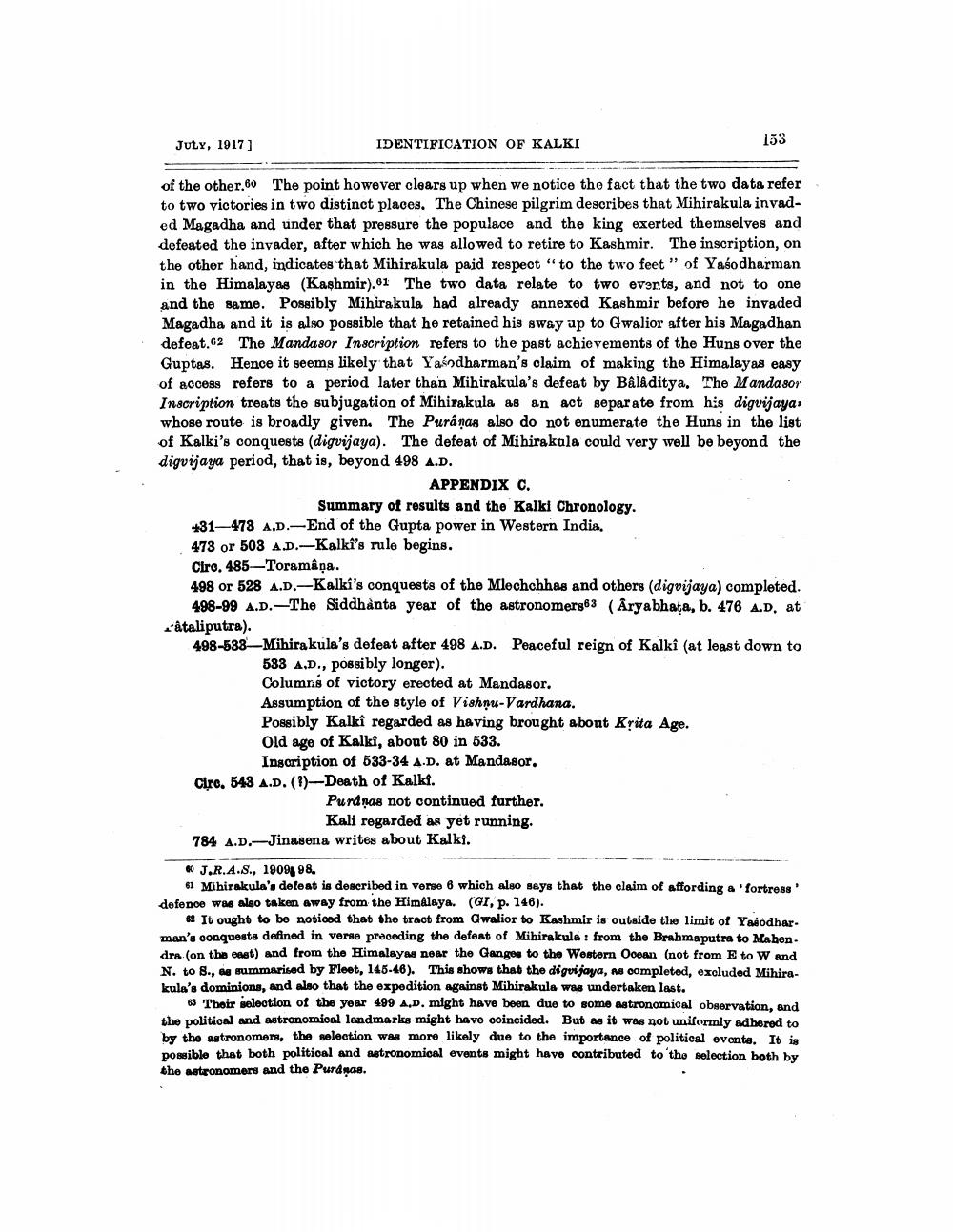________________
JULY, 1917]
IDENTIFICATION OF KALKI
of the other.60 The point however clears up when we notice the fact that the two data refer to two victories in two distinct places. The Chinese pilgrim describes that Mihirakula invaded Magadha and under that pressure the populace and the king exerted themselves and defeated the invader, after which he was allowed to retire to Kashmir. The inscription, on the other hand, indicates that Mihirakula paid respect "to the two feet" of Yasodharman in the Himalayas (Kashmir).01 The two data relate to two events, and not to one and the same. Possibly Mihirakula had already annexed Kashmir before he invaded Magadha and it is also possible that he retained his sway up to Gwalior after his Magadhan defeat.62 The Mandasor Inscription refers to the past achievements of the Huns over the Guptas. Hence it seems likely that Yasodharman's claim of making the Himalayas easy of access refers to a period later than Mihirakula's defeat by Bâlâditya. The Mandasor Inscription treats the subjugation of Mihirakula as an act separate from his digvijaya, whose route is broadly given. The Puranas also do not enumerate the Huns in the list of Kalki's conquests (digvijaya). The defeat of Mihirakula could very well be beyond the digvijaya period, that is, beyond 498 A.D.
APPENDIX C.
Summary of results and the Kalki Chronology. +31-478 A.D.-End of the Gupta power in Western India. 473 or 508 A.D.-Kalki's rule begins.
Circ. 485-Toramâna.
498 or 528 A.D.-Kalki's conquests of the Mlechchhas and others (digvijaya) completed. 498-99 A.D.-The Siddhanta year of the astronomers63 (Aryabhata, b. 476 A.D. at âtaliputra).
153
498-533-Mihirakula's defeat after 498 A.D. Peaceful reign of Kalkî (at least down to
533 A.D., possibly longer).
Columns of victory erected at Mandasor.
Assumption of the style of Vishnu-Vardhana.
Possibly Kalki regarded as having brought about Krita Age.
Old age of Kalkî, about 80 in 533. Inscription of 533-34 A.D. at Mandasor.
Circ. 543 A.D. (?)-Death of Kalki.
Puranas not continued further. Kali regarded as yet running. 784 A.D.-Jinasena writes about Kalki.
60 J.R.A.S., 1909 98.
61 Mihirakula's defeat is described in verse 6 which also says that the claim of affording a 'fortress' defence was also taken away from the Himalaya. (GI, p. 146).
62 It ought to be noticed that the tract from Gwalior to Kashmir is outside the limit of Yasodhar. man's conquests defined in verse preceding the defeat of Mihirakula: from the Brahmaputra to Mahen. dra (on the east) and from the Himalayas near the Ganges to the Western Ocean (not from E to W and N. to 8., as summarised by Fleet, 145-46). This shows that the digvijaya, as completed, excluded Mihirakula's dominions, and also that the expedition against Mihirakula was undertaken last.
63 Their selection of the year 499 A.D. might have been due to some astronomical observation, and the political and astronomical landmarks might have coincided. But as it was not uniformly adhered to by the astronomers, the selection was more likely due to the importance of political events. It is possible that both political and astronomical events might have contributed to the selection both by the astronomers and the Puranas.




